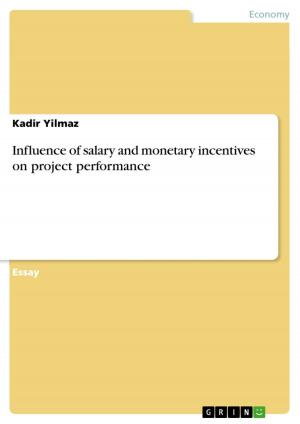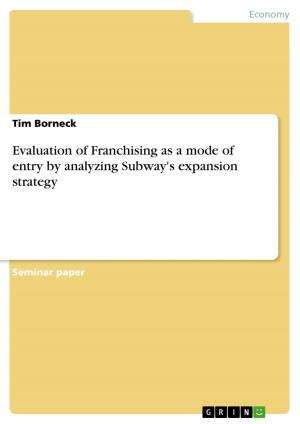Organizational Barriers and Employees' Resistance in Strategic Change Processes
Business & Finance, Management & Leadership, Management| Author: | Thao Binh Pham Thi | ISBN: | 9783638359009 |
| Publisher: | GRIN Publishing | Publication: | March 18, 2005 |
| Imprint: | GRIN Publishing | Language: | English |
| Author: | Thao Binh Pham Thi |
| ISBN: | 9783638359009 |
| Publisher: | GRIN Publishing |
| Publication: | March 18, 2005 |
| Imprint: | GRIN Publishing |
| Language: | English |
Seminar paper from the year 2003 in the subject Business economics - Business Management, Corporate Governance, grade: 1,0, University of Hannover (Unternehmensführung und Organisation), 33 entries in the bibliography, language: English, abstract: The impact of strategic change processes on the organization and its individuals Dramatic environmental shifts due to the rapid increase of dynamic and complexity have put organizations under high pressure.1 Consequently organizations are forced to undergo strategic changes in order to create organizational adaptability and flexibility to prevail in heavily disputed markets.2 However, although organizational change 3 is considered to be essential the success rate of change is still very low. The reasons for these failures are quite obvious but they are not well acknowledged. However one crucial reason is that employees and organizations, the change targets, do not welcome changes at all.4 Moreover as a natural reaction they will inevitably resist change.5 Considering these difficulties the resistance of organizations and its members to changes should be seen as the central challenge of change management and be taken seriously to improve the change performance of organizations. 6 To meet this challenge it is essential that change agents7 acknowledges as well as understands resistance already at an early stage so that adequate strategies can be developed at the right time. In consequence the management of change should focus on a constructive approach of resistance since it is stated as one of the key success factors of change management.8 The objective of this paper is to give firstly comprehensive reasons why organizational barriers and employees' resistance towards change exist and secondly reasonable methods that are able to reduce and overcome resistance to change. The paper consists of two crucial parts. The first one is the analysis of resistance consisting of the two elements recognizing the symptoms and understanding the reasons of resistance. The second part deals with ways to handle resistance by applying different kinds of effective methods in order to overcome resistance as well as to create a framework within future changes can be carried out more easily... --- 1 Swanda (1979), p. 497. 2 Reiß (1997a), p. 6. 3 In this paper organizational change is used as the synonym for strategic change. 4 Strebel (1998), pp. 140-141. 5 Robbins (1998), p. 632. 6 Pardo del Val/Fuentes, p. 148. 7 Change agents are those who conduct change directly whereas change managers have the overall responsi- bilities for the change and its success; Connor/Lake (1994), p. 12. 8 Connor/Lake (1994), p. 133.
Seminar paper from the year 2003 in the subject Business economics - Business Management, Corporate Governance, grade: 1,0, University of Hannover (Unternehmensführung und Organisation), 33 entries in the bibliography, language: English, abstract: The impact of strategic change processes on the organization and its individuals Dramatic environmental shifts due to the rapid increase of dynamic and complexity have put organizations under high pressure.1 Consequently organizations are forced to undergo strategic changes in order to create organizational adaptability and flexibility to prevail in heavily disputed markets.2 However, although organizational change 3 is considered to be essential the success rate of change is still very low. The reasons for these failures are quite obvious but they are not well acknowledged. However one crucial reason is that employees and organizations, the change targets, do not welcome changes at all.4 Moreover as a natural reaction they will inevitably resist change.5 Considering these difficulties the resistance of organizations and its members to changes should be seen as the central challenge of change management and be taken seriously to improve the change performance of organizations. 6 To meet this challenge it is essential that change agents7 acknowledges as well as understands resistance already at an early stage so that adequate strategies can be developed at the right time. In consequence the management of change should focus on a constructive approach of resistance since it is stated as one of the key success factors of change management.8 The objective of this paper is to give firstly comprehensive reasons why organizational barriers and employees' resistance towards change exist and secondly reasonable methods that are able to reduce and overcome resistance to change. The paper consists of two crucial parts. The first one is the analysis of resistance consisting of the two elements recognizing the symptoms and understanding the reasons of resistance. The second part deals with ways to handle resistance by applying different kinds of effective methods in order to overcome resistance as well as to create a framework within future changes can be carried out more easily... --- 1 Swanda (1979), p. 497. 2 Reiß (1997a), p. 6. 3 In this paper organizational change is used as the synonym for strategic change. 4 Strebel (1998), pp. 140-141. 5 Robbins (1998), p. 632. 6 Pardo del Val/Fuentes, p. 148. 7 Change agents are those who conduct change directly whereas change managers have the overall responsi- bilities for the change and its success; Connor/Lake (1994), p. 12. 8 Connor/Lake (1994), p. 133.















